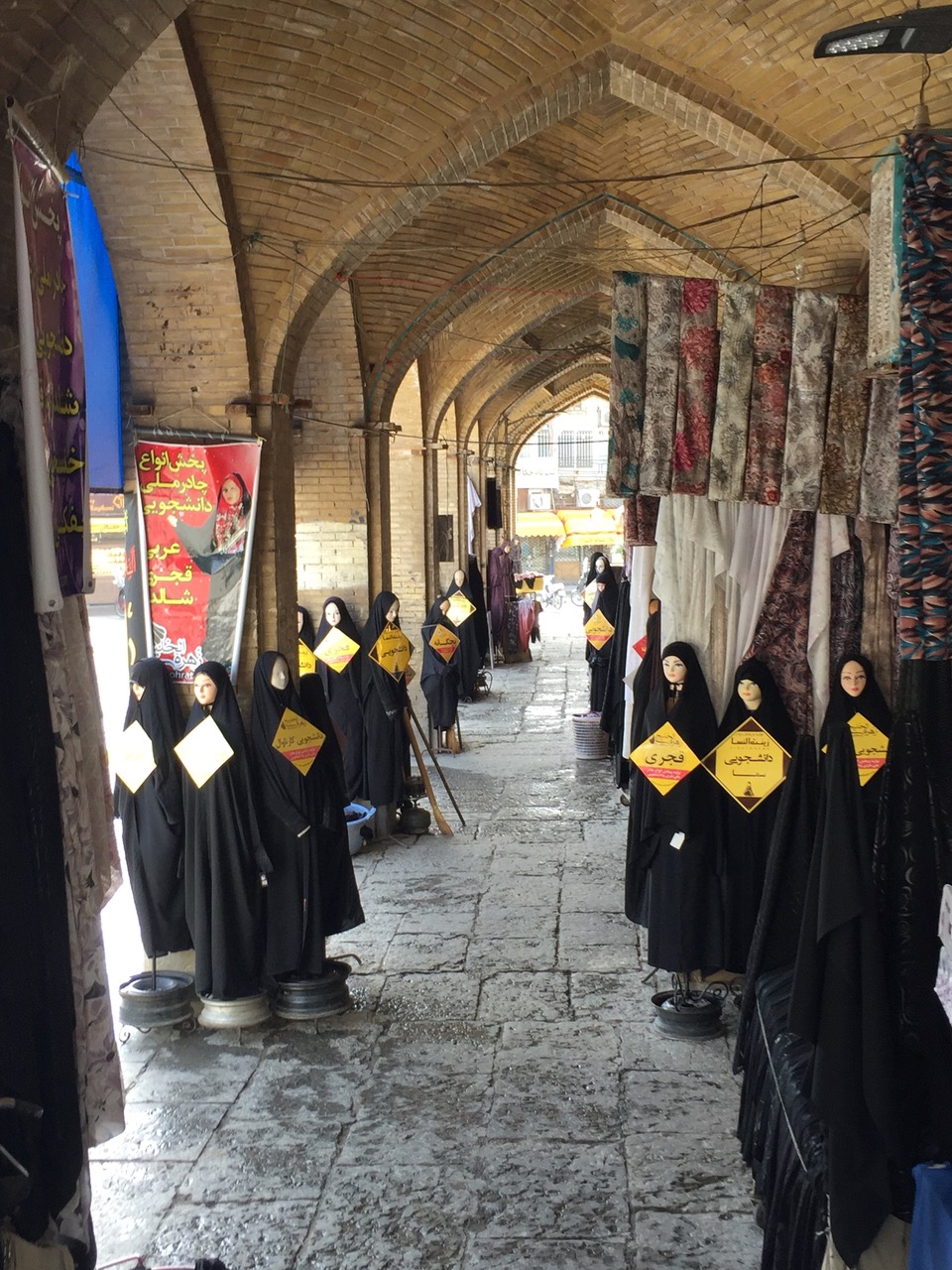Iran
Since reading Robert Byron’s The Road to Oxiana many years ago I wanted to visit Iran, the heart of the ancient Persian empire, to see the ruins of Persepolis, the beehive-like ice houses in the desert, the ancient palaces and mosques, the scented gardens and of course to taste the food. I was fortunate enough to go earlier this year with a friend who is a talented ceramicist with a wide knowledge of Middle Eastern ceramics.Since reading Robert Byron’s The Road to Oxiana many years ago I wanted to visit Iran, the heart of the ancient Persian empire, to see the ruins of Persepolis, the beehive-like ice houses in the desert, the ancient palaces and mosques, the scented gardens and of course to taste the food. I was fortunate enough to go earlier this year with a friend who is a talented ceramicist with a wide knowledge of Middle Eastern ceramics.
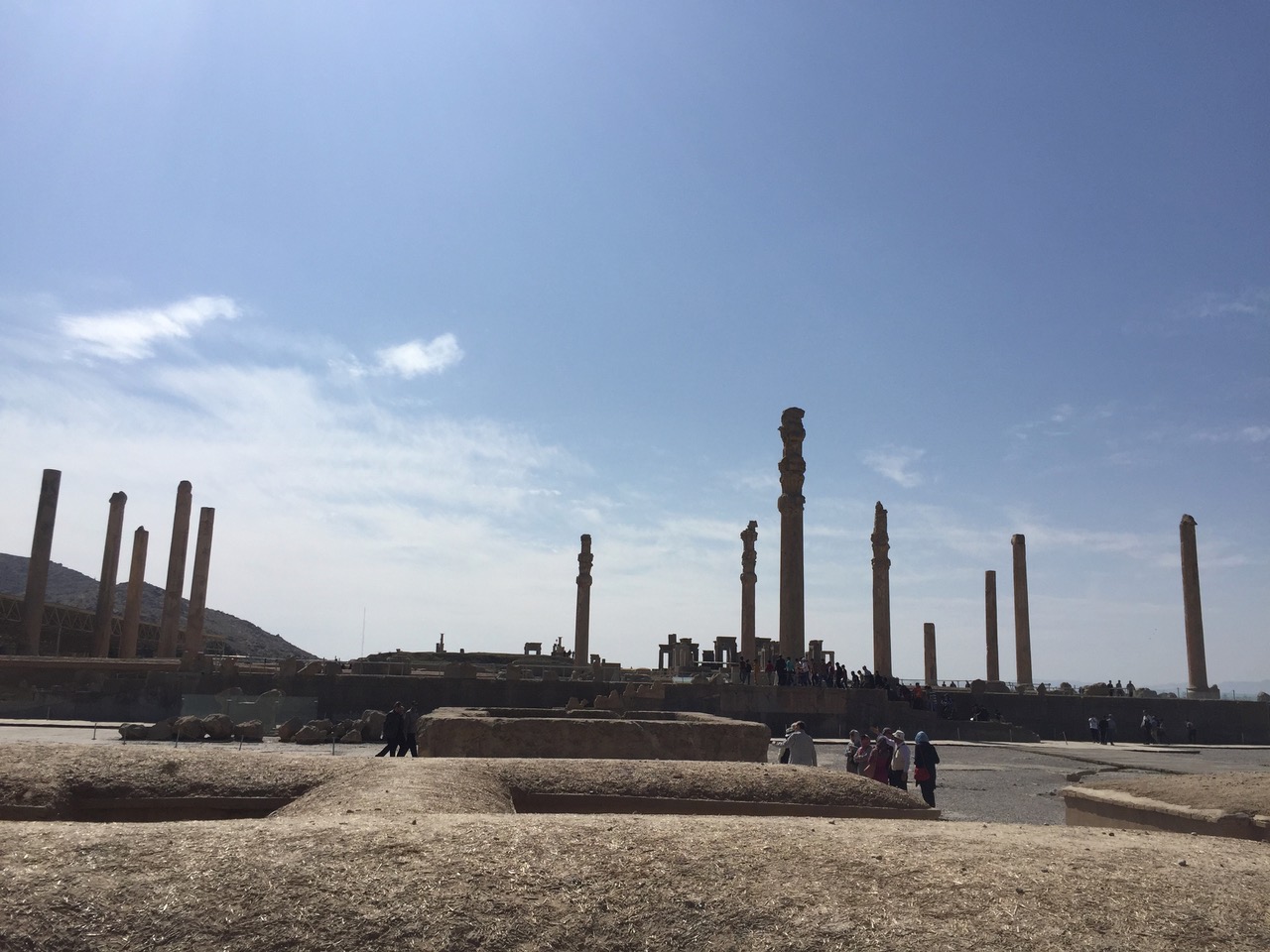
We stayed for two weeks, travelling mostly by car with the obligatory guide, starting in Tehran, a dry, polluted city, surrounded by the snow-capped Alborz mountains. Narrow canals, bordered by plane trees, run along many of the main avenues and give the city a more attractive aspect. Once these delivered drinking water, brought down in qanats from the mountains.
The old royal centre, now marked by the Golestan palace and the main bazaar, form the centre of the city. The bazaar is vast and home to one of the best kebab restaurants, constantly busy with locals and a few tourists eating kebabs with flat bread, yogurt, pickles and usually half a raw onion. It was bustling, tightly packed, with good-humoured staff and customers.
Tehran’s museums have fine collections of pre-Islamic and Islamic art and artefacts. They are surprisingly empty, except for the jewellery museum in the vault of the Melli Bank. Here there are displays of exquisite jewellery, large platters full of precious stones and many other treasures acquired over centuries as gifts or booty.
Iranians are friendly people, pleasantly surprised to see foreign visitors again, and willing to chat. We were also fortunate enough to be given introductions to delightful people in the city, who introduced us to some of the most exquisite food. We shopped at Tavazo for high quality dried fruit, nuts and spices, then lunch at Yas, an excellent restaurant. The flavours and aroma of the kebabs and the perfumed rosewater and saffron ice cream still linger in my memory. The afternoon finished with a tour of the best food bazaar with fine quality fruit, vegetables, breads, sweets and pickles.

From Tehran we flew to Kerman, then by car to Bam, stopping en route to visit Mahan, a small town with the beautiful mausoleum of the Sufi Shah Nematollah Vali, built in the 15th century and set in a tranquil garden. Bam, a desert citadel, was destroyed by earthquake in 2003. Thanks to UNESCO the rebuilding is proceeding well, using mud and straw bricks as in the original city. Bam was an important trading post on the Silk Road, a sophisticated oasis city with citadel, bazaar, stables, baths, ice house, ghetto and a Zoroastrian temple. Our guide, who had been mayor of the new town of Bam, introduced us to Bam lemons, round, pale-skinned and eaten as oranges, but more thirst quenching. He also took us to a good restaurant in the new town for khoresh, a lamb and aubergine stew.
After lunch we drove back along the ‘heroin highway’ to Kerman and next day went on to Shiraz, stopping at Sarvestan to see restoration work on a Sasanid hunting lodge (C2-6 AD). It was remote, in the middle of an arid plain, a simple yet beautiful structure in keeping with the landscape.
In Shiraz, we ate dinner at Seven Tables, a building housing seven different restaurants. We chose the traditional one and sat cross-legged on a carpeted raised platform with the food placed in the centre. We had fesenjan, chicken cooked with walnuts and pomegranate molasses, served with saffron rice, and pomegranate juice to drink. We were the only foreigners there, surrounded by Iranian families and groups of friends enjoying good food and pleasant surroundings.
Shiraz was the city I most wanted to visit and it didn’t disappoint. The botanic gardens, formerly the royal gardens, were full of spring flowers, rose bushes and impressive trees. Water is one of the main features with basins and fountains fed by water from ancient qanats. Shiraz is the city of roses, they decorate tiles and wall hangings and above all the walls of the Nasir-el-Molk mosque. In the 13th and 14th centuries it was a literary centre, home to Persia’s two best-known poets: Sa’adi and Hafez. Their tombs, set in gardens, are places of pilgrimage. At Hafez’s tomb people walk up quietly to observe the tomb, to sit in the garden and read his poetry. The next day we drove to Bishapur, a city built in Sasanian times (266 AD) to commemorate the Persian victory over the Romans. Some of the superb large bas reliefs carved into the cliff face of a gorge show the Romans lined up to pay tribute to Shapur, their Persian conqueror. Others show Arab nomads in positions of submission. The cliff overlooks the Shapur river, where below us women were washing rugs in the river. The city ruins remain, stone walls with semi-circular towers, traces of a palace and below ground level a square fire temple with high walls and a covered walkway around it, which offered protection from the heat of the sun. Across this desert landscape roamed sheep and goats tended by women in the brightly coloured clothes of nomads.
We left early the following day to Persepolis, built by the Achaemenians under Darius and added to by Xerxes (522-465 BC) as a place to hold the New Year celebrations. Alexander the Great came in 330 BC; Persepolis surrendered but was plundered; many buildings were destroyed by fire and it was abandoned.

The site was built to impress, and it does. It stands on a man-made terrace above the ground, so that all you see until you are in the site are the tall columns. When you reach the terrace you stand before the magnificently carved gate. This was once a vast complex of palaces and temples; all the walls are intricately carved, showing processions of different peoples coming to pay tribute, with their animals or goods, overseen by Persian officials. There is too much to see in one visit; apart from the grandeur of the site, so much detail deserves to be looked at closely.
Our next destination was Pasargadae, the capital of Cyrus the Great (550-629 BC). Little remains of the city, there are ruins scattered over a bleak plain, but one structure is still there – the majestic tomb of Cyrus. It stands on a small platform, a simple tomb of large limestone slabs that dominates the empty landscape. It is a windy, deserted place yet there is a sense of presence.
Yazd, our next destination, is a desert town of low brick buildings. Roofs are often domed and the most striking feature is their rectangular wind towers. They have openings on all sides to catch the wind and allow air to circulate inside the houses and cool them. Inside the towers is an ingenious structure of overlapping panels that direct the air downwards. A water basin beneath the tower cools the incoming air and so the rooms around it.
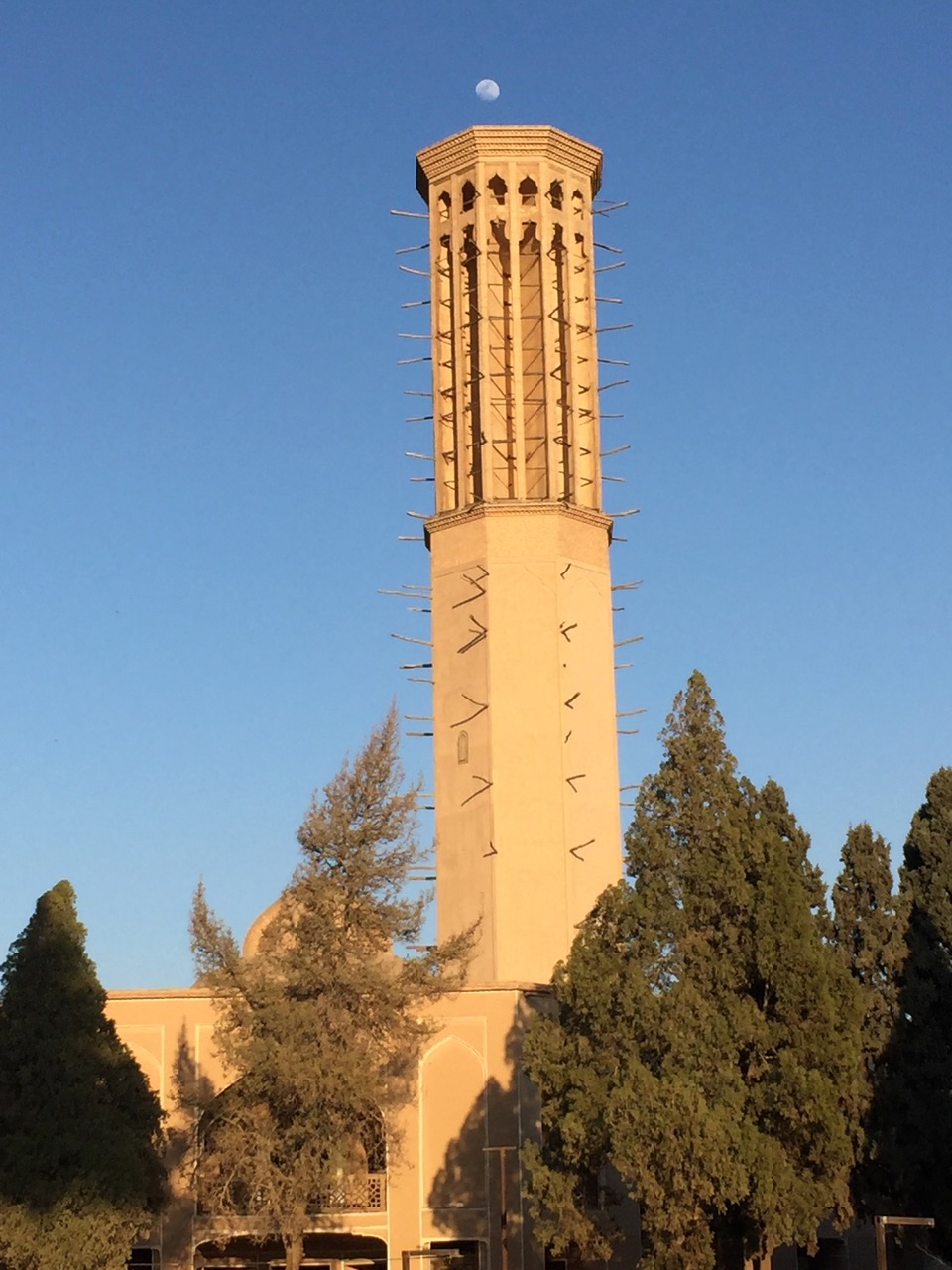
The old town is a pleasant place to wander through alleys lined with small hotels, weaving and sewing workshops, carpet shops, a 14th century mosque and many houses in the process of restoration. The flat rooftops give a fine view of the wind towers and the cityscape. Caesar’s Restaurant provided an excellent lunch of tacheen, a dish of chicken baked in saffron rice. It was presented as if turned out from a basin with a golden crust all round, and pieces of chicken and barberries inside. Then we wandered in the handsome vaulted bazaar.
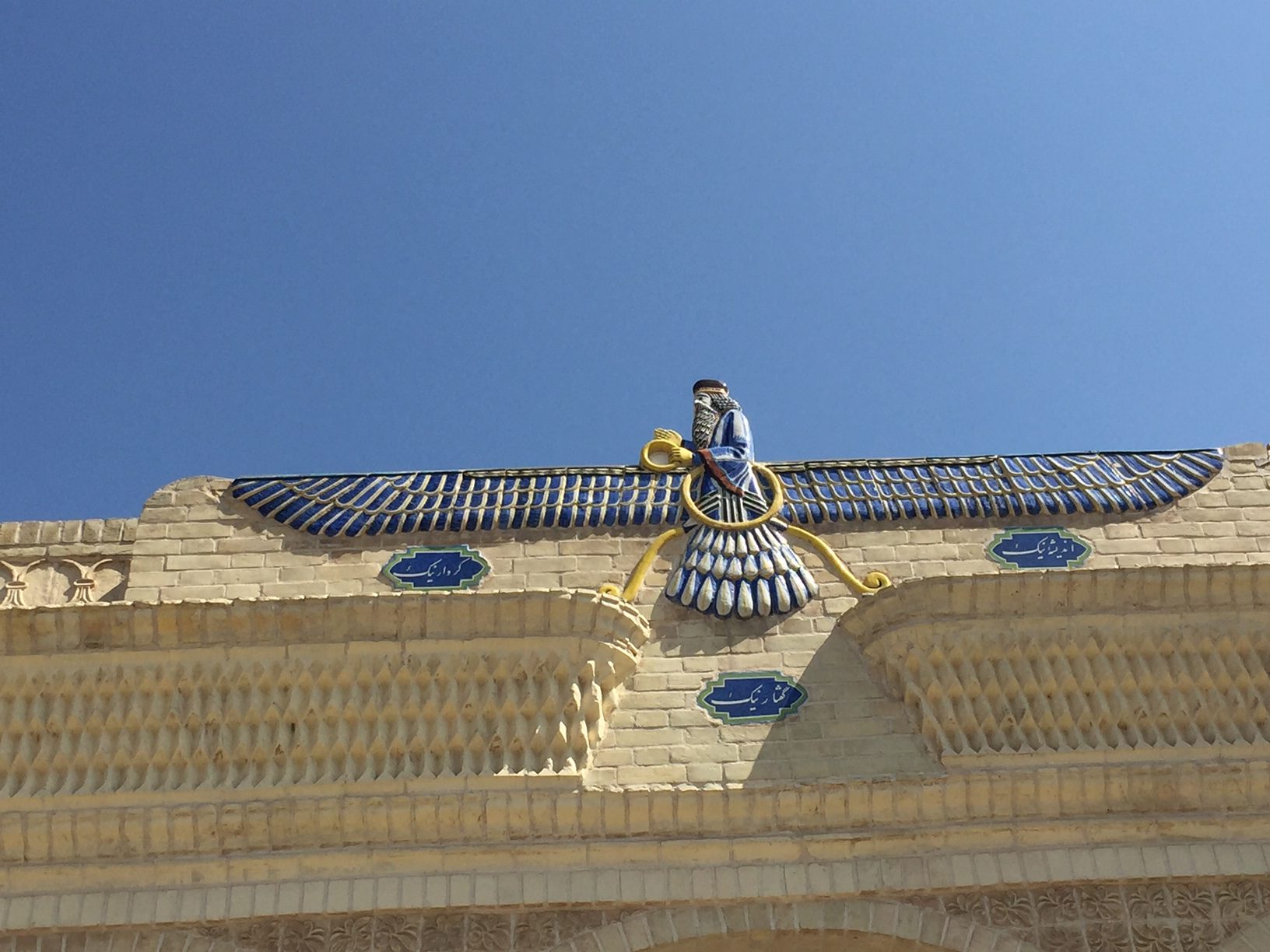
The water supply of Yazd comes from the surrounding Shir mountains through a system of qanats. Some lead to the fine prince’s garden UNESCO has restored; a long water with fountains is the central feature with a pomegranate orchard and a vineyard to one side.
Yazd still has a significant Zoroastrian community, identified by their brightly coloured clothes. The sacred fire is kept burning permanently in the modern Zoroastrian fire temple, where worshippers can see the fire through a glass panel. Over the door is the blue and gold symbol of the winged sun, the god Ahura Mazda, as in Persepolis. On the outskirts of the city are the towers of silence and the cemetery. In the past bodies were laid out in the towers and once stripped of the flesh by vultures, the priests threw the bones into a pit at the centre of the tower. Now bodies are required to be buried.
Then came a long drive through a flat arid landscape, always with mountains in the background. Here and there scrub, but for the most part only the occasional chicken farm, looking remarkably like UK battery farms, although all the chicken we ate was well flavoured. It was too hot (and in winter would be too cold) for birds to be outdoors. We wondered what breed they raised to withstand the climate and to produce good meat.
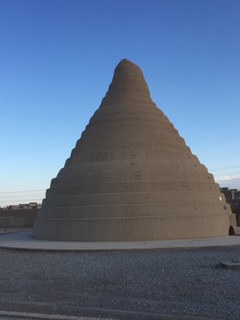
We had a brief stop at Meybod to see the restored ice house, complete with its long shallow pool protected from the sun by a high wall. Inside we stood on a high circular gallery with a deep inverted brick pyramid at the centre. The ice that formed on the pool in winter was stored here for use during the summer. The Persians always prized ice in summer and at the time of Shah Abbas it was in great demand to cool wine. Opposite was a caravanserai with a complex qanat system; it’s now restored as tourist shops, but lacked customers.
Esfahan is a city of splendid monuments on a grand scale, but the only place where the hotel was ghastly. We cheered up after a good dinner at an art-deco styled restaurant, Sheherazade, staffed by elderly, courteous waiters in black suits. It was full, largely with locals. Grilled Persian Gulf shrimp kebab and rice with fresh orange juice, followed by saffron ice cream restored good humour.Esfahan was the capital of the Seljuks in the 13th century and Shah Abbas moved his capital here in the late 16th century. Our first day in the city started at the impressive Imam Square, a vast open space. At one end is the Royal Mosque, to one side in the centre is the Ali Qapu Palace and opposite it the Lotfollah Mosque. The bazaar extends around the rest of the square with its main entrance at the opposite end of the square to the Royal Mosque. This was originally the place where caravans came to unload at the merchants’ premises. Later it became the place for celebrations and polo games which the shah and his court watched from the palace terrace (the stone goal posts are still there). The Royal Mosque has fine ornamental calligraphy and elegant repeated patterns on the walls inside. The Lotfollah Mosque is smaller and has exquisite tiled and stucco ornament in gold, turquoise, deep blue and green; the patterns change as you move around. The bazaar has a tempting selection of weaving shops and more jewellery and decorative arts than elsewhere. Fine miniature paintings on camel bone, and boxes made of camel bone, painted with birds or flowers are a local speciality.
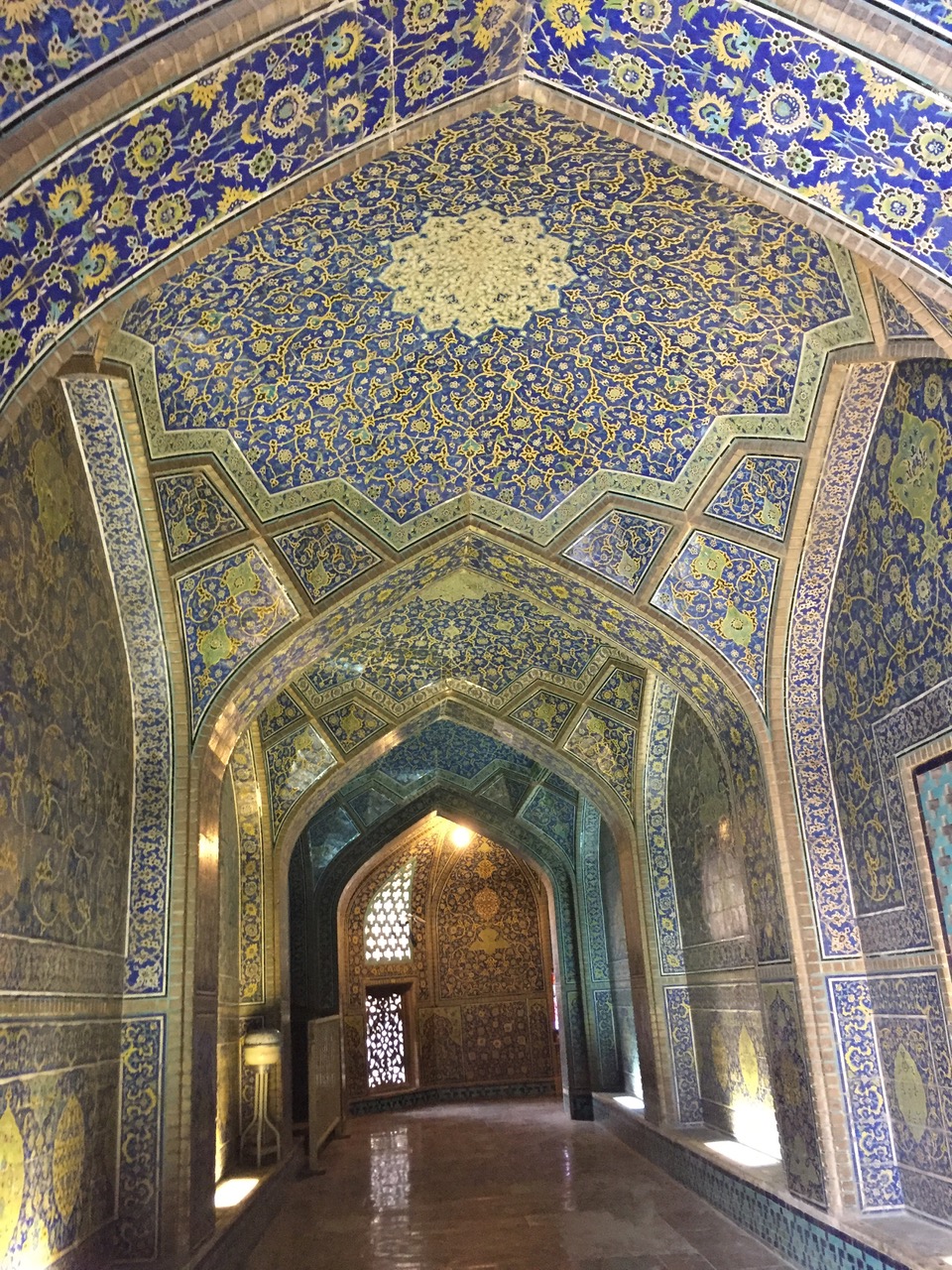
In the afternoon we walked along a tree-lined path by the dry bed of the Zayandheh River to see the old bridges. There is a chronic shortage of water (due to bad planning?) in the city and for agriculture further downstream. Many locals, mostly women in flapping chadors, were walking across the dry mud.
The oldest bridge – Pol-e Shahrestan dates from 12th century – a simple style with ten arches; further upstream is Pol-e Khaju with its sluice gate that once ensured the water supply for the town. It was built by Shah Abbas and can be crossed at different levels. In the lowest arches was a group of young people listening to a guitarist, out of sight and sound of the moral police. Further upstream still is the Si-o-Se pol, the bridge of 33 arches built to connect the city with the suburb of Jolfa in the 1600s. Dinner again at Sheherazade – lamb and rice this time. The owner, seeing us return, came and chatted, wanting to know about England.
As we left the hotel the following morning we were both hugged by a well-dressed young woman who said in halting English that she was so pleased to see visitors. We set off for Jolfa, the Armenian suburb with its 17th century cathedral. There was a large trading population of Armenians here at that time; numbers have now shrunk but there is still a significant community. The cathedral has murals of biblical stories and Armenian script, although some of the floral decoration is Mughal-inspired. In the grounds is a fine, small museum with early books. At a nearby Armenian restaurant we had a good early lunch with many varied salads to choose from in a buffet. Then we rushed to get to the 14th century shaking minarets mosque for midday, when the minarets are shaken. Someone goes up to the roof and pushes one of the minarets which starts to shake and eventually the roof moves slightly as does the other minaret (detected by the sound of bells ringing more than in distinct visible movement). No one knows whether this was intentional on the part of the architect or accidental.
A broad, tree-lined Chahar Bagh Avenue was built to connect the royal centre to the river and across to Jolfa. Today it is lined with smart shops and cafes. Along it is the Chehel Sotan, the palace of 40 columns, in a pleasant park. The long water in front and the garden and fountains around it create a harmonious whole. In the evening we admired the splendid gardens of the Abbasi hotel, an old caravanserai that has been well restored. We finished with more saffron ice cream and coffee in the café.
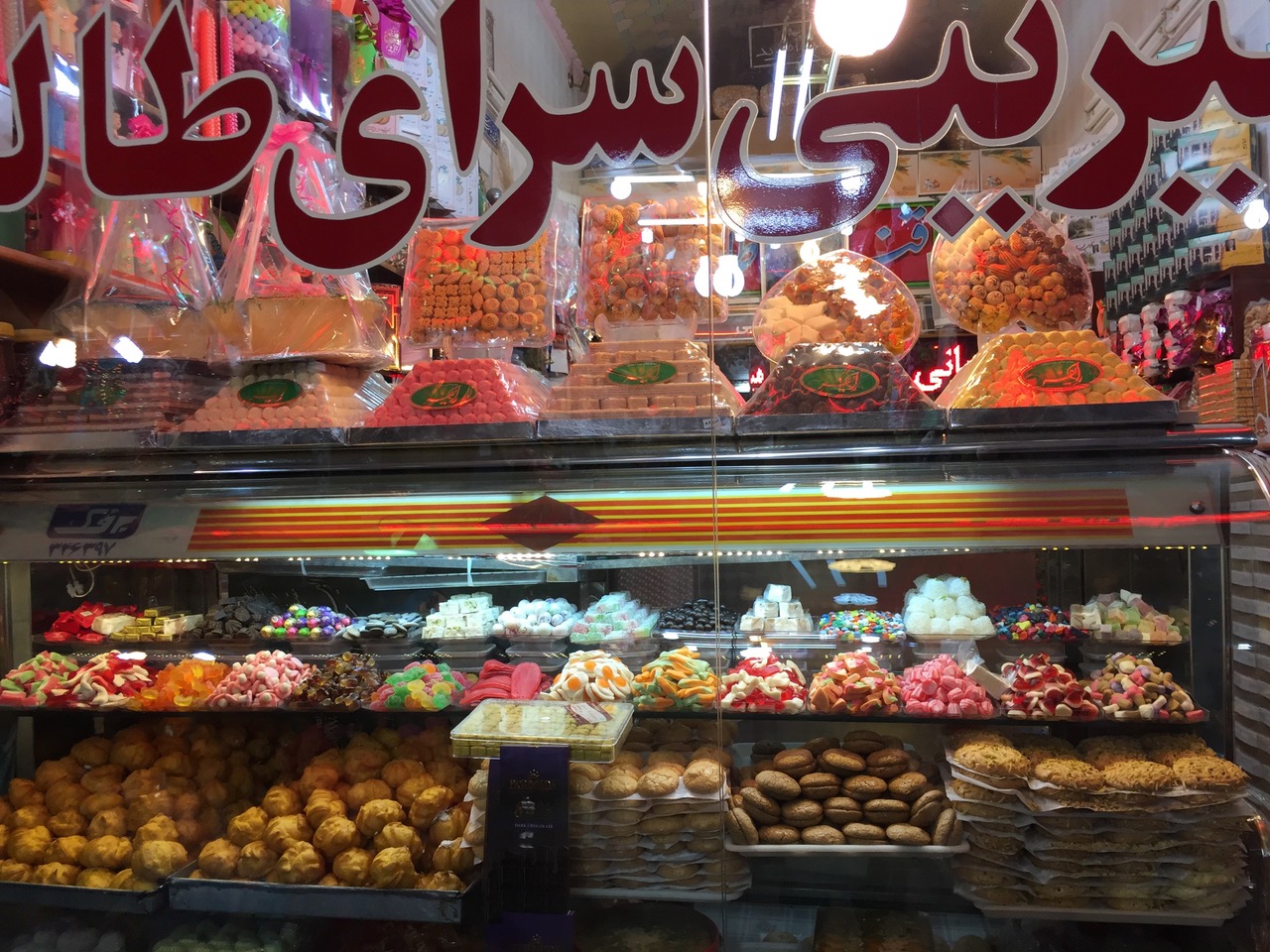
The following morning the road to Natanz led through hilly, at times mountainous, terrain; it was rather bleak with few villages. We stopped at one hamlet to see a ruined village across the highway and bought warm flat bread from the local baker. Natanz is a small town with an old mosque, now somewhat in need of restoration. We visited a ceramics workshop belonging to two elderly brothers, both renowned as master craftsmen. Carole was very interested is looking at their colours and techniques; I bought a beautiful small green flask with Koranic inscriptions.
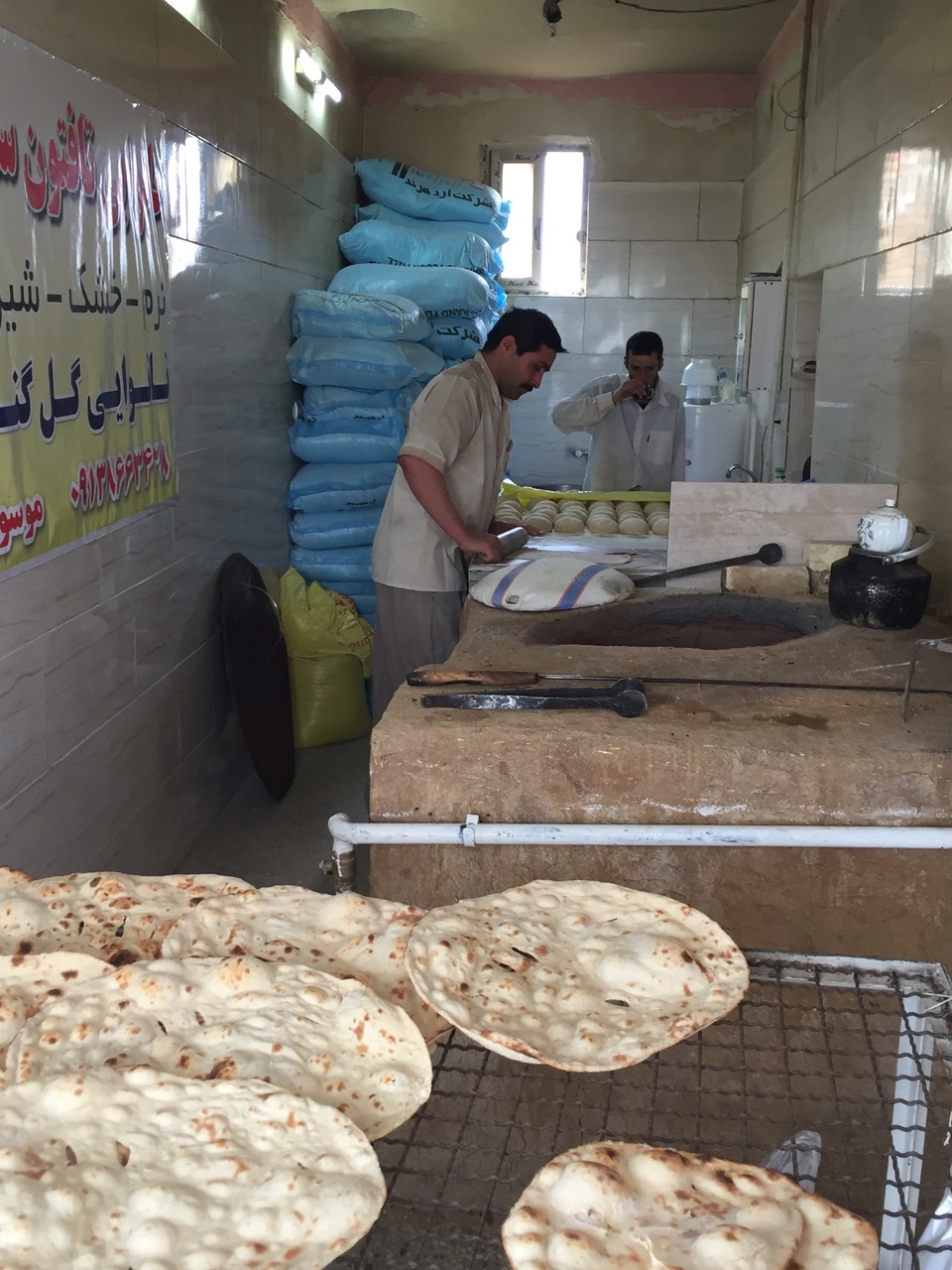
We drove on to Kashan through the same bleak landscape, passing the Iranian nuclear plant, with appropriate defences and signs warning not to stop anywhere on the road. The afternoon was spent at the Bagh-e Fin, a beautiful garden designed for Shah Abbas. It is well laid out with hedged garden squares, trees, shrubs and spring flowers. Water dominates, with many canals and pools. A pavilion stands over the junction of two canals. At one end of the garden is a small summer house and a pool with bubbling springs. To one side is the hamam and other service buildings, to the other a fine small museum with ceramics and calligraphy. Kashan was a prosperous oasis noted for its ceramics, tiles, carpets and silks; the old town houses are now being bought and restored.
Tea at the Manoucheri hotel developed from restored old houses around a fine garden, where we met the designer, who had also put in workshops to start silk weaving again. Kashan is also famed for its flavoured waters; rose is the most popular, but many had spice or other floral flavours. We bought Noroos (New Year) cookies of cardamom-flavoured shortbread from a smart sweet shop, very busy with everyone buying for the holidays. A visit to the bazaar, a fine space with a dome in one part, and then a good dinner at the Manoucheri, with more vegetables and fruit than often encountered.
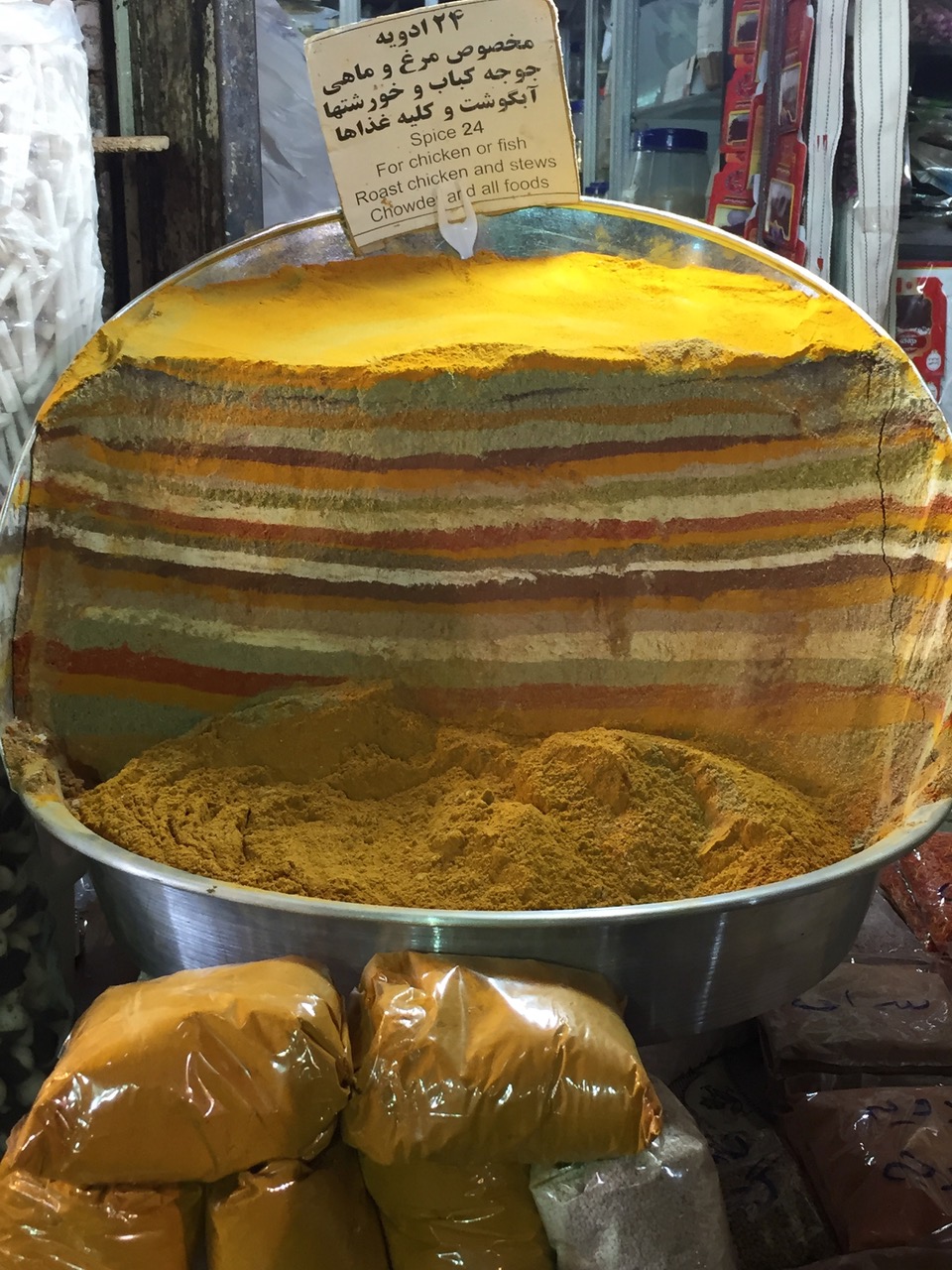
Next day we drove to Tehran for a couple more museum visits and more Noroos purchases. The New Year festival marks the spring solstice and is the most important in Iran. It lasts for 13 days; families clean their houses, invite relatives and friends (or go travelling – the plane to London the next day was full). Special foods are prepared for the festivities. Seven objects beginning with S are placed on the table: sabzi (seeds), sir (garlic), serke (vinegar) sib (apples), senjed (jujubes), samanu (a type of halva) and sekeh (a gold coin).
On our last evening, the last Wednesday before the New Year we saw traditional small bonfires burning in the streets. Everyone jumps over them to bring good health for the coming year. Officially they are banned, but the police seemed to turn a blind eye. There were giant eggs, decorated by children in one well-lit park, and fire works and paper lanterns lit by candles floating up into the sky watched by an enthusiastic crowd. It was a memorable last evening.
